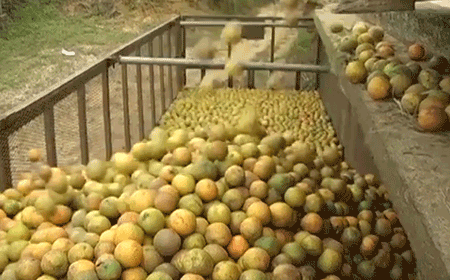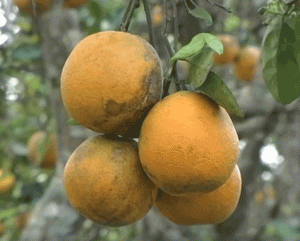The biggest story in citrus, however, is still the deadly disease that has reduced production on the over forty thousand acres of citrus in Belize by more than two-thirds.
BELIZE CITY, Thurs. Oct. 17, 2019– News from the citrus industry keeps getting worse. In recent years the industry has experienced serious turmoil over the ownership of two factories and their extensive citrus orchards, and there have been serious divisions amongst growers over the direction of the industry, and all this has been occurring at a time when the industry has been hit by a devastating disease called Citrus Greening.
There is hope, if new resilient varieties can deliver on their promise, but the strain of an industry that has been in decline for some years now is proving too much for some of its stakeholders, many of whom are barely staying afloat. In a story on News5 on Wednesday night, Isani Cayetano reported on troubled times in the Citrus Growers Association (CGA), the organization that has steered the industry since the 1960s. In the story, “Is CGA Heading for Bankruptcy?” News5 reported that “two hundred and sixty-nine citrus growers are in limbo and their employees face unemployment” and that the Citrus Growers Association can’t deliver basic services to its members. The CGA’s creditors are reportedly moving to “crowfoot” the association’s assets. A meeting set up with the Prime Minister did not go through, and they have basically been told to “get their house in order”, News5 said.
Anthony Chanona, a former senator and longtime citrus grower, shared with us a proposal from some citrus growers to resuscitate the troubled CGA, which the group says cannot be allowed to go under after its 50 years of resiliently serving the citrus industry. The group says that the pioneering CGA must continue to bring “stability, confidence and functionality of critical grower services to the citrus industry in Belize and its membership of over 250 citrus growers.” The group has outlined a course for CGA members to decide on before the body engages the government for assistance in subsidies and in securing loans to restructure the industry. One key the group has cited is a healing of the rift between the CGA and the new BCM (Belize Citrus Mutual).
The battles between the large citrus growers and the small citrus growers at the AGMs (Annual General Meetings), as they fought over the direction of the industry and the choice of a leader for the association, are legendary. Around 2010/11 the large citrus growers successfully broke away from the CGA, forming the Belize Citrus Mutual, a growers association in the service of mostly their members. This split in the citrus body was a severe blow to the CGA, and as mentioned, it came at a particularly bad time because the industry is presently battling Citrus Greening, a disease that could prove as lethal to citrus as Panama Disease was to bananas. Panama disease destroyed the banana industry in Belize in the 1920’s.
Citrus Greening has affected citrus production worldwide. Fourteen years after Citrus Greening appeared in Florida, orange production is down over 70% and grapefruit production is down over 80%. Belize has been hit extremely hard by the disease. Luis G. Tzul, an agronomist from the CGA, reported on statistics from the Statistical Institute of Belize which show that in 2005-06, Belize produced almost 8 million boxes of fruits and the industry earned over $120 million. The citrus industry has been our number one foreign exchange earner in a number of years, but the Central Bank reported that the 2017/2018 crop was just 2.6 million boxes, and the industry contributed only $55 million in foreign exchange earnings.
The industry has seen a number of ownership changes at the factory level over the years. Luis G. Tzul, in his “Report of damage by Hurricane Richard to the Citrus Industry of Belize” says the first factory to process fruits was established at Middlesex in Stann Creek in 1933 by the Citrus Company of British Honduras. In 1942 this factory was transferred to Pomona, Mile 12 on the Hummingbird Highway, and a second factory was set up by Salada Foods at Alta Vista, Mile 14, on the Hummingbird Highway, in 1963.
In 2002 the CGA gained near 100% ownership of both factories, and formed the CPBL – Citrus Products of Belize Limited; however they quickly moved to partner with two companies in the Caribbean, Banks Holdings Limited of Barbados and a company from Trinidad. Presently, the CGA is a minority shareholder in CPBL, and with its present state of financial affairs it runs the risk of losing even more shares to its creditors, which includes the Social Security Board of Belize.
The biggest story in citrus, however, is still the deadly disease that has reduced production on the over forty thousand acres of citrus in Belize by more than two-thirds. Nikita Usher, the Chief Administration Manager of CPBL, told News5 that production is down to 2.5 million boxes (from around 8 million boxes a little over a decade ago) and that the factory (CPBL is only running one factory at this time) can process that quantity of fruits in three months.
In the heyday of citrus, both factories would be operating deep into the night from November/December to May. Belizeans from the villages in the Cayo District who were interested in jobs were certain of finding employment in the harvesting season because the Stann Creek District did not have enough workers to pick the abundant fruits in the Valley.
Now the industry is laying off workers, and others are being put on shifts, working only a couple or three days in the week.


